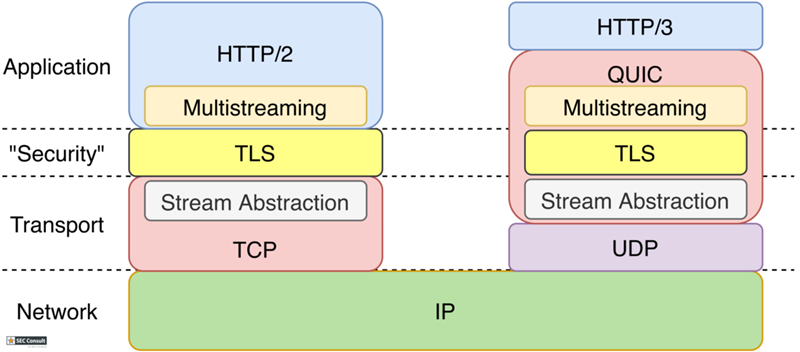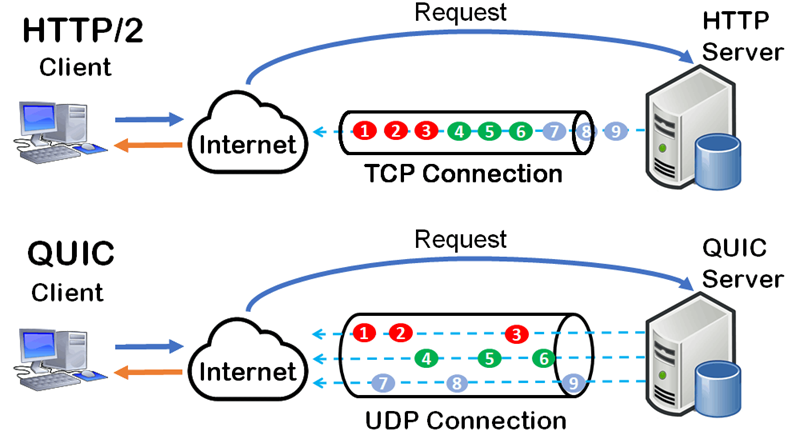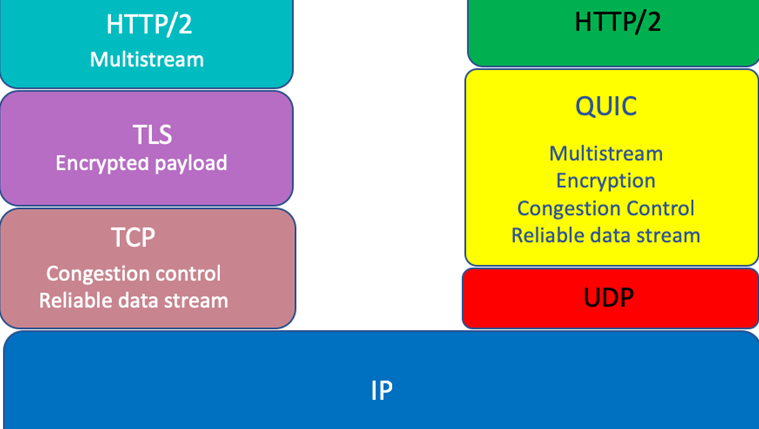The Quick UDP Internet Connections (QUIC) protocol, developed by Google, is a transport layer protocol that promises to make the internet faster and more reliable. Currently, QUIC is undergoing rapid evolution, with Google Chrome and other internet services already implementing it. The main thing that makes QUIC stand out is its ability to reduce the round-trip time (RTT) significantly, thereby enhancing the speed of web page loading and data transfer.
This is achieved through its innovative design that combines the HTTP/2, TCP, UDP, and TLS protocols into one. Unlike the traditional TCP+TLS+HTTP/2 stack which requires multiple round trips to establish a connection, QUIC does it in a single round trip, thus saving time. Furthermore, QUIC is designed to work well even under poor network conditions, thanks to its robust congestion control mechanisms and error correction capabilities. In terms of security, QUIC is at least as secure as TLS.
The Internet Engineering Task Force (IETF) is currently developing and experimenting with QUIC, aiming to standardize it. Despite the potential benefits, there are some criticisms of QUIC, such as its higher complexity compared to TCP and its potential to create new attack surfaces for hackers. In conclusion, QUIC is a promising technology that has the potential to revolutionize internet communications, but it is still under development and there are issues that need to be addressed.
Why QUIC Matters
QUIC (Quick UDP Internet Connections) is a transport layer protocol developed by Google to enhance and speed up the web browsing experience by reducing latency. Its significance lies in the solutions it offers to the problems commonly encountered with TCP (Transmission Control Protocol). TCP, the traditional protocol of the internet, often experiences high latency due to its requirement for a significant number of round trips before data transfer can begin. This results in slower web page load times, especially with poor network conditions.
QUIC, on the other hand, streamlines this process by enabling a faster connection establishment. It merges the traditional three-step connection process into a single step, reducing the latency for connection establishment. Furthermore, it improves on TCP’s congestion control and loss recovery mechanisms. QUIC employs a more advanced approach to detect and recover from packet loss without requiring retransmission of subsequent packets, thus preventing a bottleneck effect. This is especially beneficial for streaming media, where packet loss can severely impact the quality of the stream.
Moreover, QUIC is designed with built-in encryption features, providing enhanced security for data transmission. This is particularly critical in an era where cyber threats are rampant and data privacy is paramount. Lastly, QUIC is designed to be flexible and easy to update, making it adaptable to the rapidly evolving internet landscape.
In essence, QUIC offers a faster, more secure, and more reliable internet experience. It assists in overcoming the limitations of TCP, thus significantly improving web browsing, streaming, and overall online experience. Therefore, the adoption of QUIC in internet protocols is not just a trend, but a necessity for the advancement of the digital age.

Why QUIC Matters
QUIC (Quick UDP Internet Connections) is an essential transport layer protocol that provides significant benefits over traditional protocols, especially in terms of speed and security. It is designed to enhance the performance of web applications by minimizing latency and maximizing data transfer rates. This is achieved by reducing the number of ’round trips’ that data packets need to make between client and server. It also incorporates forward error correction mechanisms to recover from packet loss without retransmission, further improving speed and efficiency.
Furthermore, QUIC incorporates robust security features that offer stronger protection for data transmission. It uses built-in TLS (Transport Layer Security) encryption for all data exchange, making it more secure than other protocols. This enhanced security makes QUIC an attractive option for sensitive applications where data integrity and protection are paramount.
Moreover, QUIC is versatile and adaptable. It is designed to operate effectively even in adverse network conditions, such as unstable or congested networks. This capability ensures consistent and reliable performance regardless of network issues, making it vital for applications that demand high availability and resilience.
Another essential feature of QUIC is its ability to support multiplexed connections. This means it can manage multiple data streams over a single connection, reducing the need for multiple connections and thereby enhancing efficiency.
QUIC’s unique combination of speed, security, adaptability, and multiplexing capability make it a game-changer in the realm of internet protocols. It offers the potential to significantly improve the performance of web applications and services, making it a critical element in the ongoing evolution of the internet. With the growing demand for faster, more secure, and reliable internet services, the importance of QUIC cannot be overstated.
The Current Status of QUIC
QUIC (Quick UDP Internet Connections) is a unique and innovative transport layer protocol developed by Google to enhance the performance of web applications by decreasing latency. As of 2021, the QUIC protocol has become increasingly significant in the world of digital communication, particularly due to its potential to speed up web traffic, improve connection reliability, and enhance security.
Initially implemented by Google in 2012, QUIC has evolved over the years and now forms the basis for HTTP/3, the third major version of the Hypertext Transfer Protocol. Since November 2020, IETF (Internet Engineering Task Force) has officially recognized QUIC as a standard transport protocol, publishing it as RFC 9000 series. This recognition has reinforced the adoption and implementation of QUIC by major digital platforms and browsers.
Today, QUIC supports a significant portion of Google’s traffic and is also adopted by prominent technology companies like Facebook. Major browsers like Chrome and Firefox have integrated QUIC in their systems, while Microsoft Edge is set to support it soon. Moreover, HTTP/3, which is built upon QUIC, is gaining momentum and looks set to become the future of web communication.
As it currently stands, the adoption of QUIC is still in progress, and some obstacles are yet to be overcome. For instance, the protocol’s dependency on UDP has led to compatibility issues with some network equipment and firewalls. Additionally, the protocol’s encryption features, while enhancing security, make it harder for network operators to manage traffic.
Despite these challenges, the ongoing evolution and adoption of QUIC indicate a promising future. With continued development and fine-tuning, QUIC has the potential to revolutionize internet communication by providing faster, more reliable, and secure connections. Therefore, the current status of QUIC can be described as a crucial and transformative phase of its integration into global digital communication infrastructures.

Key Features and Benefits of QUIC
QUIC, or Quick UDP Internet Connections, is a transport layer protocol developed by Google to enhance the performance of web applications by reducing latency. As an alternative to the traditional TCP (Transmission Control Protocol), QUIC offers several key features and benefits. Firstly, it provides multiplexing without head-of-line blocking, which significantly improves performance by allowing multiple streams to be active at the same time. Secondly, it incorporates a fast and secure connection establishment process. Unlike TCP, QUIC requires fewer round trips to establish a connection, thereby reducing connection latency.
Additionally, QUIC also enhances reliability by using Forward Error Correction (FEC). This mechanism helps recover lost data packets without retransmission, thus improving the efficiency of data transmission. It also incorporates a congestion control mechanism to prevent network congestion and optimize data flow. QUIC is designed to adapt to changing network conditions and dynamically adjusts its transmission rate based on network congestion and packet loss. This adaptive mechanism ensures smooth data transmission even under unstable network conditions.
Regarding security, QUIC uses TLS 1.3 for connection authentication and data encryption, providing robust security protection for data transmission. Another important feature is its support for connection migration. This means that even if a client’s IP address changes during a connection, the connection will not be interrupted, ensuring seamless data transfer.
In summary, QUIC offers several benefits including reduced latency, improved performance, enhanced reliability, robust security, and support for connection migration. These features make it a promising protocol for future internet applications, particularly in scenarios where low latency and high reliability are required.

Key Features and Benefits of QUIC
QUIC, an abbreviation for Quick UDP Internet Connections, is an experimental transport layer network protocol developed by Google. Some of its key features include reduced connection establishment time, improved congestion control, and multiplexing without head-of-line blocking. These features offer numerous benefits that enhance the overall efficiency and speed of internet connections. For instance, the reduced connection establishment time feature enables QUIC to establish a connection with only a single round-trip time, which greatly reduces latency, particularly in circumstances where a new connection needs to be established each time data is exchanged.
This is particularly beneficial for mobile users, where connectivity frequently changes, and for web services, where latency can significantly impact user experience. In terms of congestion control, QUIC utilizes a more advanced mechanism that allows for better differentiation between packet loss due to congestion and packet loss due to other reasons, such as poor network conditions. This results in improved network performance as it avoids unnecessary slowdowns.
Finally, the multiplexing feature of QUIC allows simultaneous transmission of multiple data streams. Unlike TCP, QUIC does not suffer from head-of-line blocking, where the delay of a single packet holds up the entire data stream. This results in a more efficient use of available network capacity, leading to improved data transmission speeds. To sum up, QUIC’s unique features offer significant improvements in terms of connection speed, reliability, and efficiency, making it a promising alternative to traditional internet protocols.
